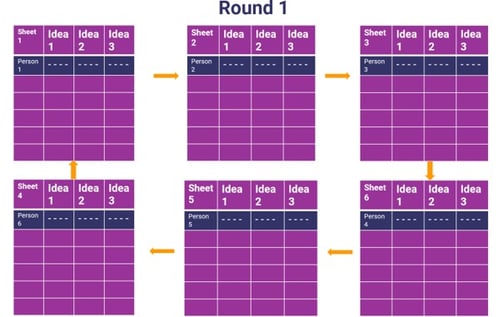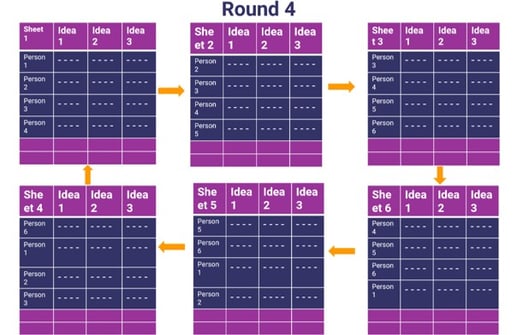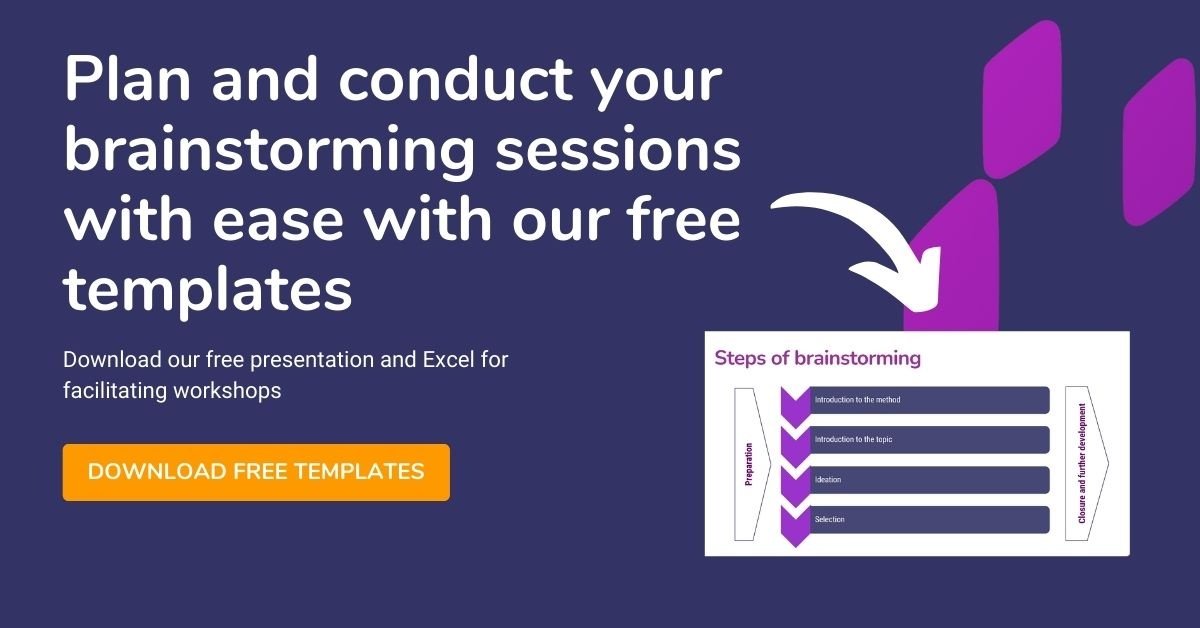Brainwriting is gaining traction among businesses around the world as a technique to solve tough problems by generating creative ideas from employees. Brainwriting is an advanced method of idea generation compared to traditional brainstorming. The biggest advantage of brainwriting is the absence of social anxiety and the fear of being judged for your ideas.
Here we’ll cover what brainwriting is, how it differs from brainstorming and methods for you to use for implementing brainwriting sessions to solve your biggest challenges.

What is Brainwriting?
Brainwriting is an innovative way to solve problems and invite new ideas. It is similar to brainstorming in the way that it encourages creative problem-solving ideas from a group. However, the difference between brainstorming and brainwriting is that in brainstorming everyone discusses the idea aloud and in brainwriting, participants write down their ideas on a piece of paper and share them anonymously with the leader. This gives the participants more confidence as they feel less judged by others for their words or thoughts.
Brainwriting vs. Brainstorming
Now that you have an idea about what brainwriting is, here are some common brainstorming challenges that brainwriting can solve.
Brainstorming is susceptible to dominating voices: Sometimes ideas from only the loudest voices on a team get heard. This stifles the creativity of others who don’t feel comfortable enough to voice their ideas. On the other hand, Brainwriting gives equal exposure to everyone.
Brainstorming can lead to false consensus: Brainstorming sessions can make participants anxious about being judged by others on the team. This fear can create a false consensus where a team member can leave the session without sharing his or her great ideas and appearing to agree with bad ideas. This is not the case with brainwriting since the ideas are generated quickly and shared anonymously to avoid the fear of being judged.
Brainstorming can be difficult for introverted creative minds: Introverted members of the team may find it difficult to discuss their ideas aloud in a group. Brainwriting lets everyone share their ideas which help introverts to unleash their creative mind.
Steps to conduct a Brainwriting session
There are several different methods to run a Brainwriting session that we’ll cover in the next section. All of these different methods use the same basic five-step process below.
The five steps of conducting a brainwriting session are:
#1. Select a moderator
Every brainstorming session should have a moderator. The first step of conducting a brainwriting step is selecting who will be the moderator, who supervises the entire brainwriting session.
#2. Plan the rounds
Dedicate a timeframe for each brainwriting round and decide how many rounds are required to solve the given problem.
#3. Begin the first round
The moderator briefs the team about the problem and hands over brainwriting templates to each participant. The moderator starts round one and asks everyone to write down their ideas without discussing them with others.
The moderator also monitors the time limit and asks everyone to stop writing after the stipulated time. The brainwriting sheets or templates are then collected and redistributed for the second round.
#4. Repeat the rounds
As the next round begins, the participants must write a second set of ideas. They can suggest new ideas or build off existing ideas that have been written by another member in the previous round. After the given amount of time, the round ends and another round begins.
#5. Discuss all ideas
At the end of all the rounds, as determined in step two, the moderator of the brainwriting session must collect all templates and share all the ideas with the team to decide on the best one.
Methods of Brainwriting
There are a few different methods you can use to conduct a brainwriting session. Here we will discuss six of the most common.
Brainwriting 635
This brainwriting process is conducted in a team of 6 members, each writing 3 ideas for 5 minutes. The template for Brainwriting 635 is designed with 3 rows and 6 columns and there should be the same amount of templates as there are participants.
The 3 rows show that a person should write down 3 ideas per round. Generally, the columns denote each team member of the 635 session.

The members should start by writing the problem on top of the Brainwriting 635 template. Then within 5 minutes, each member should write 3 ideas in the three given columns. After 5 minutes is up, the sheet will be passed on to the next member to add his or her ideas to the next columns.

At the end of the brainwriting 635 session, each 635 template will have 18 ideas. So, in total 6 members will contribute 108 ideas that can be discussed and considered to solve the problem.
Brainwriting Pool
There is no specified template for this method of brainwriting. Brainwriting pool can be done using post-it notes or small-sized cards. Each member of the team writes down their ideas and places them on the table. Then each member can pick a card or two to add more ideas. These ideas can be brand new or piggyback on existing ideas.
Idea Card Brainwriting
In this brainwriting technique, each member of the team writes down his or her ideas on a small card and piles them up on the table. The neighbor member can take one or two idea cards from the pile for inspiration to create new ideas or build on the existing ideas. You can decide the number of rounds based on the problem and the number of participants in the team.
Brainwriting Game
This is a fun way of conducting brainwriting sessions in the form of a game. This brings a more competitive approach to the session. To keep it a light-hearted game that everyone can enjoy, you have to ensure that there are no losers in this game and the winner will be decided by all the members.
Here are the steps to conduct a brainwriting game:
- Divide the members into two groups and distribute an equal number of cards to each member of both groups, for example, each team gets 20 cards.
- Announce the problem that you want a new creative solution to. Also, make it clear that the winner will be the one who comes up with the best idea.
- Set a fixed timeframe for the members to write down a certain number of ideas. The number of ideas you want from each member should be equal to the number of cards they have. So, if a team has 5 members, each of them has 4 cards. Each card should have only one idea.
- Now the moderator will sell a certain number of blank idea cards to each group member at a decided price. All the money that has been collected will be kept aside as the winning prize. After that, each member signs the cards so they can identify their cards at the end.
- After the given time of the first round, all members hand over their idea cards to be displayed on the board.
- Now another stipulated time is given to all members to read every idea on the displayed cards. At this time members can pick any idea card and amend it to make it a more relevant and meaningful solution to the problem.
- Now every member of the team will have two voting tokens (generally two stars). They can vote for the idea or card that they feel is the best solution to the problem. The idea card with the maximum number of votes wins the game and gets the pooled prize money.

Constrained Brainwriting
In this brainwriting method, the idea remains constrained to a predetermined focus. It doesn't allow for the off-the-wall creative thinking found in other brainwriting techniques. This technique is very similar to the brainwriting pool method but starts with the second round in which the existing ideas are filled to the cards. Here are the steps for the constrained brainwriting method.
- The moderator starts the process by placing stacks of brainwriting templates at the center of the table. Each template already has an idea written on it that explains the problem and the way it is expected to be solved.
- Now each member picks a template and silently goes through the idea written on them. He or she needs to add a variable to the idea or modify it to make the idea more relevant to the problem.
- If the member is unable to modify the pre-written idea then he or she can return the template to the pile on the table and pick another one to continue the process.
- After the predetermined amount of time, the first round is over. The members should place their templates on the table. Next, they will again pick the template at random from the first round or from the already stacked pile with only one idea written on the template and improve it.
- Several rounds should be conducted until all ideas are exhausted. Now the moderator will have all the ideas to review and decide which one offers the best creative solution to the problem. During the whole brainwriting process, there should not be a discussion of any kind amongst the members.
Mild Constrained Brainwriting
As the name suggests, it is a variation of the constrained brainwriting method. Here the members are given a little more liberty to do some creative thinking with one or two topics followed by subtopics.
The steps for mild constraint brainwriting are as follows:
- The members are given a brainwriting template with no ideas but only topics or problem statements on it. Each template can have more than one topic or even subtopics.
- The members should write an idea relevant to the stated topic or problem within the given time frame.
- The round can be repeated by exchanging the templates with other members until the moderator collects a satisfactory number of ideas.
- Similar to constrained brainwriting, this method also does not allow team members to engage in any form of discussion.
💡More ideation methods in our article: 16 Brainstorming Techniques for Boosting Innovation
When should you use brainwriting?
As we have mentioned earlier that brainwriting is an alternative method for brainstorming. It depends on the situation and the team if you should choose using brainwriting over brainstorming since they both have their own advantages. Brainwriting helps to overcome some of the challenges of the brainstorming process. Certain situations make it especially powerful.
Here are some of the best use cases for brainwriting to quickly get high-quality creative ideas.
- Large groups: If there is a large group brainstorming can become chaotic, brainwriting can be a great way to generate more good ideas in less time. You can easily conduct a brainwriting session with a group of 500 people or more by giving each member an idea card and setting a given time for every round.
- New groups: If the group members are not well-acquainted with the moderator, they may feel hesitant to share their ideas or engage in the discussion. Brainwriting can be a great solution to generate ideas for new groups.
- Limited time: When a creative idea is needed quickly, a brainwriting session can be a great tool. Get your team in a room and announce the problem aloud. Hand each of them a sheet of paper and give them a fixed time, say 10 minutes, to write down their ideas. Within 10 minutes you can get several creative ideas without the need for long discussions or brainstorming sessions.
- Less experienced moderator: In a brainstorming session a moderator should have experience and extensive knowledge on the topic that is being discussed to identify good ideas. In a brainwriting session, a moderator is only required to state the problem and keep track of the time for each round. The collective experience of the group identifies the best ideas.
- Equal opportunity and focus: Sometimes a brainstorming session ends up with ideas from the dominant voices only while more passive voices don’t even get a chance to speak. Brainwriting is a wonderful way to welcome equal participation and allow everyone to contribute to solving the problem.
Brainwriting tips and tricks
Here are a few tricks and tips to get the most out of every brainwriting session.
- As the process is conducted in a short time frame, some participants’ handwriting may be hard to read. This becomes difficult to decode when you need to refer to the idea again. We recommend you get the best ideas typed out or rewritten in easy-read handwriting. Note that you can also use online brainwriting tools to avoid that problem.
- Participants should be allowed to do some homework on the problem statement before the brainwriting session. This increases their knowledge of the topic and helps them come up with better ideas.
- Make the problem statement clear to all participants so that they can understand its focus and significance. Write it on a board or add it to each of the brainwriting templates.
- Be clear about the rules and the time limit. For example, if the members of a group are to pass their templates to the neighbor, all of them should pass them in a predetermined direction (right or left).
- You can use both brainwriting and brainstorming sessions to generate ideas and discuss them. You can combine the methods the way you want and make the best solutions for you. For example, change between these methods from time to time to keep the motivation high. Also, you can for example consider trying brainwriting with a new team and then start brainstorming later. The hybrid approach can really boost creativity in your company.
- You can create an affinity diagram with sticky notes using the suggested ideas. This will shape the creative solution in a better way and help participants to know which area of the problem needs more focus in the following rounds.

Final thoughts
Brainwriting is an excellent idea-generation method that allows diverse teams to come up with the most creative solutions to tough problems. If you are used to running a same-structured brainstorming session every time, it can be a good idea to change up a bit and try brainwriting instead.
Use the steps in this article to successfully moderate a brainwriting session and try a few different brainwriting methods to see which one works best for your team. You’ll be amazed at the big hairy problems you and your team are able to solve.
Hope these tips will get you started on your brainwriting sessions. Share your thoughts in the comments below!
Want to run productive and easy-to-facilitate workshops? Start using Orchidea for free, and let our built-in process guide your team through writing down their ideas into feasible solutions.





